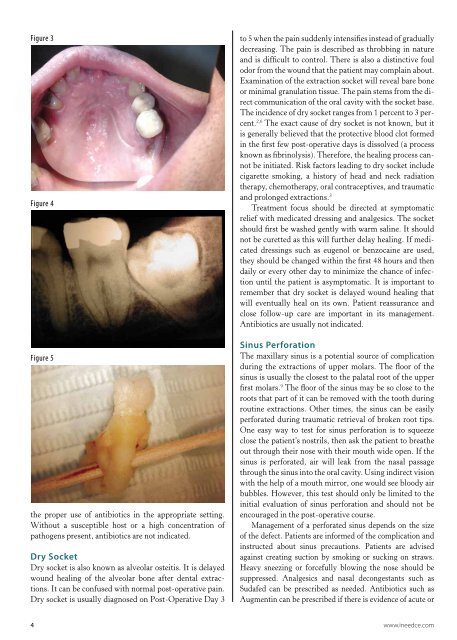Management of Complications of Dental Extractions - IneedCE.com
Management of Complications of Dental Extractions - IneedCE.com
Management of Complications of Dental Extractions - IneedCE.com
You also want an ePaper? Increase the reach of your titles
YUMPU automatically turns print PDFs into web optimized ePapers that Google loves.
Figure 3<br />
Figure 4<br />
Figure 5<br />
the proper use <strong>of</strong> antibiotics in the appropriate setting.<br />
Without a susceptible host or a high concentration <strong>of</strong><br />
pathogens present, antibiotics are not indicated.<br />
Dry Socket<br />
Dry socket is also known as alveolar osteitis. It is delayed<br />
wound healing <strong>of</strong> the alveolar bone after dental extractions.<br />
It can be confused with normal post-operative pain.<br />
Dry socket is usually diagnosed on Post-Operative Day 3<br />
to 5 when the pain suddenly intensifies instead <strong>of</strong> gradually<br />
decreasing. The pain is described as throbbing in nature<br />
and is difficult to control. There is also a distinctive foul<br />
odor from the wound that the patient may <strong>com</strong>plain about.<br />
Examination <strong>of</strong> the extraction socket will reveal bare bone<br />
or minimal granulation tissue. The pain stems from the direct<br />
<strong>com</strong>munication <strong>of</strong> the oral cavity with the socket base.<br />
The incidence <strong>of</strong> dry socket ranges from 1 percent to 3 percent.<br />
2,6 The exact cause <strong>of</strong> dry socket is not known, but it<br />
is generally believed that the protective blood clot formed<br />
in the first few post-operative days is dissolved (a process<br />
known as fibrinolysis). Therefore, the healing process cannot<br />
be initiated. Risk factors leading to dry socket include<br />
cigarette smoking, a history <strong>of</strong> head and neck radiation<br />
therapy, chemotherapy, oral contraceptives, and traumatic<br />
and prolonged extractions. 3<br />
Treatment focus should be directed at symptomatic<br />
relief with medicated dressing and analgesics. The socket<br />
should first be washed gently with warm saline. It should<br />
not be curetted as this will further delay healing. If medicated<br />
dressings such as eugenol or benzocaine are used,<br />
they should be changed within the first 48 hours and then<br />
daily or every other day to minimize the chance <strong>of</strong> infection<br />
until the patient is asymptomatic. It is important to<br />
remember that dry socket is delayed wound healing that<br />
will eventually heal on its own. Patient reassurance and<br />
close follow-up care are important in its management.<br />
Antibiotics are usually not indicated.<br />
Sinus Perforation<br />
The maxillary sinus is a potential source <strong>of</strong> <strong>com</strong>plication<br />
during the extractions <strong>of</strong> upper molars. The floor <strong>of</strong> the<br />
sinus is usually the closest to the palatal root <strong>of</strong> the upper<br />
first molars. 9 The floor <strong>of</strong> the sinus may be so close to the<br />
roots that part <strong>of</strong> it can be removed with the tooth during<br />
routine extractions. Other times, the sinus can be easily<br />
perforated during traumatic retrieval <strong>of</strong> broken root tips.<br />
One easy way to test for sinus perforation is to squeeze<br />
close the patient’s nostrils, then ask the patient to breathe<br />
out through their nose with their mouth wide open. If the<br />
sinus is perforated, air will leak from the nasal passage<br />
through the sinus into the oral cavity. Using indirect vision<br />
with the help <strong>of</strong> a mouth mirror, one would see bloody air<br />
bubbles. However, this test should only be limited to the<br />
initial evaluation <strong>of</strong> sinus perforation and should not be<br />
encouraged in the post-operative course.<br />
<strong>Management</strong> <strong>of</strong> a perforated sinus depends on the size<br />
<strong>of</strong> the defect. Patients are informed <strong>of</strong> the <strong>com</strong>plication and<br />
instructed about sinus precautions. Patients are advised<br />
against creating suction by smoking or sucking on straws.<br />
Heavy sneezing or forcefully blowing the nose should be<br />
suppressed. Analgesics and nasal decongestants such as<br />
Sudafed can be prescribed as needed. Antibiotics such as<br />
Augmentin can be prescribed if there is evidence <strong>of</strong> acute or<br />
4 www.ineedce.<strong>com</strong>

















